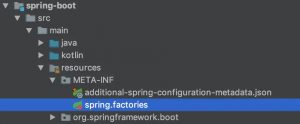前言
本文所涉及spring/spring boot代码,请参考spring boot 2.2.6对应版本。
我们在刚学习spring boot时,有没有一个困惑:spring boot能够自动实例化很多第三方的依赖库?比如eureka、druid等。这个就涉及到spring boot的扩展机制spring factories。
简单来将,spring factories类似与Java SPI机制,利用该机制,我们能够自定义实现一些SDK或是spring boot starter,其实例化过程由我们来实现,使用方只需要在项目中引入包、不需要或是只需做很少的配置。
Spring Factories的核心
spring factories机制核心在spring-core包中定义的SpringFactoriesLoader类,该类的公有方法只有2个:
/*
根据接口类获取其实现类的实例,这个方法返回的是对象列表。
Load and instantiate the factory implementations of the given type from "META-INF/spring.factories", using the given class loader.
The returned factories are sorted through AnnotationAwareOrderComparator.
If a custom instantiation strategy is required, use loadFactoryNames(java.lang.Class<?>, java.lang.ClassLoader) to obtain all registered factory names.
*/
public static <T> List<T> loadFactories(Class<T> factoryType, @Nullable ClassLoader classLoader)
/*
根据接口获取其接口类的名称,这个方法返回的是类名的列表。
Load the fully qualified class names of factory implementations of the given type from "META-INF/spring.factories", using the given class loader.
*/
public static List<String> loadFactoryNames(Class<?> factoryType, @Nullable ClassLoader classLoader)
而上面这两个方法,最终都会调用一个SpringFactoriesLoader的私有方法loadSpringFactories,从指定的ClassLoader中获取spring.factories文件,并解析得到类名列表。具体代码如下:
private static Map<String, List<String>> loadSpringFactories(@Nullable ClassLoader classLoader) {
MultiValueMap<String, String> result = cache.get(classLoader);
if (result != null) {
return result;
}
try {
Enumeration<URL> urls = (classLoader != null ?
classLoader.getResources(FACTORIES_RESOURCE_LOCATION) :
ClassLoader.getSystemResources(FACTORIES_RESOURCE_LOCATION));
result = new LinkedMultiValueMap<>();
while (urls.hasMoreElements()) {
URL url = urls.nextElement();
UrlResource resource = new UrlResource(url);
Properties properties = PropertiesLoaderUtils.loadProperties(resource);
for (Map.Entry<?, ?> entry : properties.entrySet()) {
String factoryTypeName = ((String) entry.getKey()).trim();
for (String factoryImplementationName : StringUtils.commaDelimitedListToStringArray((String) entry.getValue())) {
result.add(factoryTypeName, factoryImplementationName.trim());
}
}
}
cache.put(classLoader, result);
return result;
}
catch (IOException ex) {
throw new IllegalArgumentException("Unable to load factories from location [" +
FACTORIES_RESOURCE_LOCATION + "]", ex);
}
}
该代码作用:遍历整个ClassLoader中所有jar包下的spring.factories文件。spring.factories文件的位置:jar包下META-INF/spring.factories。
有没有感觉很熟悉?Java SPI的读取目录在META-INF/services下,其实大家写代码都是相互参考、然后形成一个约定俗成习惯的。
我们可以在自己的jar中配置spring.factories文件,不会影响到其它地方的配置,也不会被别人的配置覆盖。
示例
举个例子,spring boot start的实现中,如下所示:

spring-boot的spring.factories具体内容如下:
# PropertySource Loaders
org.springframework.boot.env.PropertySourceLoader=\
org.springframework.boot.env.PropertiesPropertySourceLoader,\
org.springframework.boot.env.YamlPropertySourceLoader
# Run Listeners
org.springframework.boot.SpringApplicationRunListener=\
org.springframework.boot.context.event.EventPublishingRunListener
# Error Reporters
org.springframework.boot.SpringBootExceptionReporter=\
org.springframework.boot.diagnostics.FailureAnalyzers
# Application Context Initializers
org.springframework.context.ApplicationContextInitializer=\
org.springframework.boot.context.ConfigurationWarningsApplicationContextInitializer,\
org.springframework.boot.context.ContextIdApplicationContextInitializer,\
org.springframework.boot.context.config.DelegatingApplicationContextInitializer,\
org.springframework.boot.rsocket.context.RSocketPortInfoApplicationContextInitializer,\
org.springframework.boot.web.context.ServerPortInfoApplicationContextInitializer
# Application Listeners
org.springframework.context.ApplicationListener=\
org.springframework.boot.ClearCachesApplicationListener,\
org.springframework.boot.builder.ParentContextCloserApplicationListener,\
org.springframework.boot.cloud.CloudFoundryVcapEnvironmentPostProcessor,\
org.springframework.boot.context.FileEncodingApplicationListener,\
org.springframework.boot.context.config.AnsiOutputApplicationListener,\
org.springframework.boot.context.config.ConfigFileApplicationListener,\
org.springframework.boot.context.config.DelegatingApplicationListener,\
org.springframework.boot.context.logging.ClasspathLoggingApplicationListener,\
org.springframework.boot.context.logging.LoggingApplicationListener,\
org.springframework.boot.liquibase.LiquibaseServiceLocatorApplicationListener
# Environment Post Processors
org.springframework.boot.env.EnvironmentPostProcessor=\
org.springframework.boot.cloud.CloudFoundryVcapEnvironmentPostProcessor,\
org.springframework.boot.env.SpringApplicationJsonEnvironmentPostProcessor,\
org.springframework.boot.env.SystemEnvironmentPropertySourceEnvironmentPostProcessor,\
org.springframework.boot.reactor.DebugAgentEnvironmentPostProcessor
# Failure Analyzers
org.springframework.boot.diagnostics.FailureAnalyzer=\
org.springframework.boot.diagnostics.analyzer.BeanCurrentlyInCreationFailureAnalyzer,\
org.springframework.boot.diagnostics.analyzer.BeanDefinitionOverrideFailureAnalyzer,\
org.springframework.boot.diagnostics.analyzer.BeanNotOfRequiredTypeFailureAnalyzer,\
org.springframework.boot.diagnostics.analyzer.BindFailureAnalyzer,\
org.springframework.boot.diagnostics.analyzer.BindValidationFailureAnalyzer,\
org.springframework.boot.diagnostics.analyzer.UnboundConfigurationPropertyFailureAnalyzer,\
org.springframework.boot.diagnostics.analyzer.ConnectorStartFailureAnalyzer,\
org.springframework.boot.diagnostics.analyzer.NoSuchMethodFailureAnalyzer,\
org.springframework.boot.diagnostics.analyzer.NoUniqueBeanDefinitionFailureAnalyzer,\
org.springframework.boot.diagnostics.analyzer.PortInUseFailureAnalyzer,\
org.springframework.boot.diagnostics.analyzer.ValidationExceptionFailureAnalyzer,\
org.springframework.boot.diagnostics.analyzer.InvalidConfigurationPropertyNameFailureAnalyzer,\
org.springframework.boot.diagnostics.analyzer.InvalidConfigurationPropertyValueFailureAnalyzer
# FailureAnalysisReporters
org.springframework.boot.diagnostics.FailureAnalysisReporter=\
org.springframework.boot.diagnostics.LoggingFailureAnalysisReporter
spring boot如何利用spring.factories进行注入
一个spring boot项目,在启动类上会有@SpringBootApplication注解,该注解实现:
@Target(ElementType.TYPE)
@Retention(RetentionPolicy.RUNTIME)
@Documented
@Inherited
@SpringBootConfiguration
@EnableAutoConfiguration
@ComponentScan(excludeFilters = { @Filter(type = FilterType.CUSTOM, classes = TypeExcludeFilter.class),
@Filter(type = FilterType.CUSTOM, classes = AutoConfigurationExcludeFilter.class) })
public @interface SpringBootApplication {
...
}
其中,@EnableAutoConfiguration注解定义大体如下:
@Target(ElementType.TYPE)
@Retention(RetentionPolicy.RUNTIME)
@Documented
@Inherited
@AutoConfigurationPackage
@Import(AutoConfigurationImportSelector.class)
public @interface EnableAutoConfiguration {
...
}
其中@Import(AutoConfigurationImportSelector.class) 很关键,@Import注解通过快速导入的方式实现把实例加入spring的IOC容器中,可以用于导入第三方包。AutoConfigurationImportSelector实现了ImportSelector接口,任何实现ImportSelector的类,都会在启动时被spring-context包ConfigurationClassParser中的processImports进行实例化,并执行selectImports方法。
AutoConfigurationImportSelector的selectImports以及相关的方法实现如下:
/*
这部分是AutoConfigurationImportSelector的代码
*/
public String[] selectImports(AnnotationMetadata annotationMetadata) {
if (!isEnabled(annotationMetadata)) {
return NO_IMPORTS;
}
AutoConfigurationMetadata autoConfigurationMetadata = AutoConfigurationMetadataLoader
.loadMetadata(this.beanClassLoader);
AutoConfigurationEntry autoConfigurationEntry = getAutoConfigurationEntry(autoConfigurationMetadata,
annotationMetadata);
return StringUtils.toStringArray(autoConfigurationEntry.getConfigurations());
}
protected AutoConfigurationEntry getAutoConfigurationEntry(AutoConfigurationMetadata autoConfigurationMetadata,
AnnotationMetadata annotationMetadata) {
if (!isEnabled(annotationMetadata)) {
return EMPTY_ENTRY;
}
AnnotationAttributes attributes = getAttributes(annotationMetadata);
List<String> configurations = getCandidateConfigurations(annotationMetadata, attributes);
configurations = removeDuplicates(configurations);
Set<String> exclusions = getExclusions(annotationMetadata, attributes);
checkExcludedClasses(configurations, exclusions);
configurations.removeAll(exclusions);
configurations = filter(configurations, autoConfigurationMetadata);
fireAutoConfigurationImportEvents(configurations, exclusions);
return new AutoConfigurationEntry(configurations, exclusions);
}
protected List<String> getCandidateConfigurations(AnnotationMetadata metadata, AnnotationAttributes attributes) {
List<String> configurations = SpringFactoriesLoader.loadFactoryNames(getSpringFactoriesLoaderFactoryClass(),
getBeanClassLoader());
Assert.notEmpty(configurations, "No auto configuration classes found in META-INF/spring.factories. If you "
+ "are using a custom packaging, make sure that file is correct.");
return configurations;
}
protected Class<?> getSpringFactoriesLoaderFactoryClass() {
return EnableAutoConfiguration.class;
}
/*
下面是AutoConfigurationMetadataLoader中的代码
*/
protected static final String PATH = "META-INF/spring-autoconfigure-metadata.properties";
static AutoConfigurationMetadata loadMetadata(ClassLoader classLoader) {
return loadMetadata(classLoader, PATH);
}
static AutoConfigurationMetadata loadMetadata(ClassLoader classLoader, String path) {
try {
Enumeration<URL> urls = (classLoader != null) ? classLoader.getResources(path)
: ClassLoader.getSystemResources(path);
Properties properties = new Properties();
while (urls.hasMoreElements()) {
properties.putAll(PropertiesLoaderUtils.loadProperties(new UrlResource(urls.nextElement())));
}
return loadMetadata(properties);
}
catch (IOException ex) {
throw new IllegalArgumentException("Unable to load @ConditionalOnClass location [" + path + "]", ex);
}
}
可以看到,AutoConfigurationImportSelector的selectImports方法主要是用于加载类,但为了获取哪些类需要加载,则是通过SpringFactoriesLoader去加载对应的spring.factories。大体调用链路:
AutoConfigurationImportSelector#selectImports()
-> AutoConfigurationImportSelector#getAutoConfigurationEntry()
-> AutoConfigurationImportSelector#getCandidateConfigurations()
-> SpringFactoriesLoader#loadFactoryNames()
最终执行的是 loadFactoryNames(EnableAutoConfiguration.class, 当前classloader), 结合上面Spring Factories的核心这一小节,可以获知,SpringFactoriesLoader将会根据EnableAutoConfiguration接口,去所有spring.factories找EnableAutoConfiguration.class所对应的values,并返回。
常见扩展点
上面已经提到,spring factories需要给出一个spring.factories文件,该文件规定了bean注入的扩展点。
常见扩展点如下:
# Auto Configure(这个扩展是使用的最多的,特别是是一些公共SDK,会这借助这扩展实现Bean的自动注入)
org.springframework.boot.autoconfigure.EnableAutoConfiguration
# PropertySource Loaders
org.springframework.boot.env.PropertySourceLoader
# Run Listeners
org.springframework.boot.SpringApplicationRunListener
# Error Reporters
org.springframework.boot.SpringBootExceptionReporter
# Application Context Initializers
org.springframework.context.ApplicationContextInitializer
# Application Listeners
org.springframework.context.ApplicationListener
# Environment Post Processors
org.springframework.boot.env.EnvironmentPostProcessor
# Failure Analyzers
org.springframework.boot.diagnostics.FailureAnalyzer
# FailureAnalysisReporters
org.springframework.boot.diagnostics.FailureAnalysisReporter